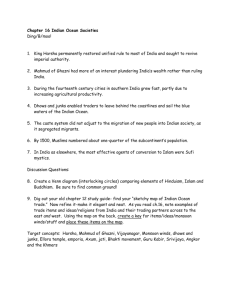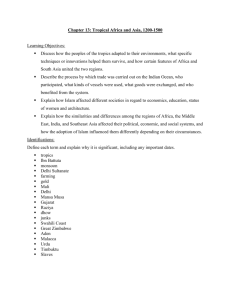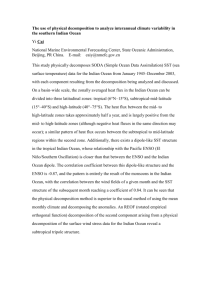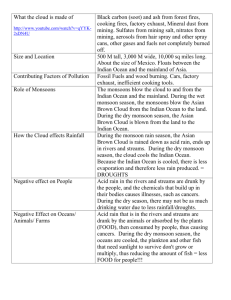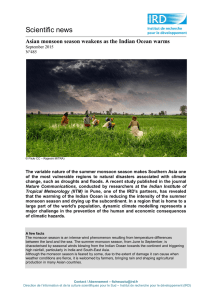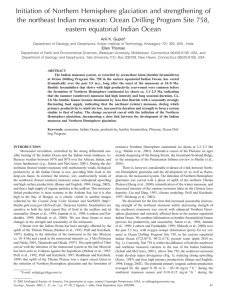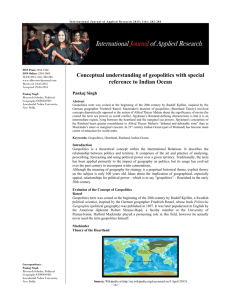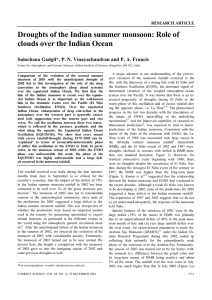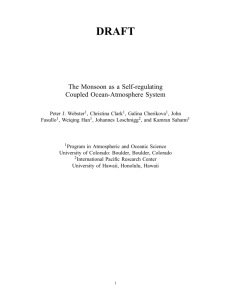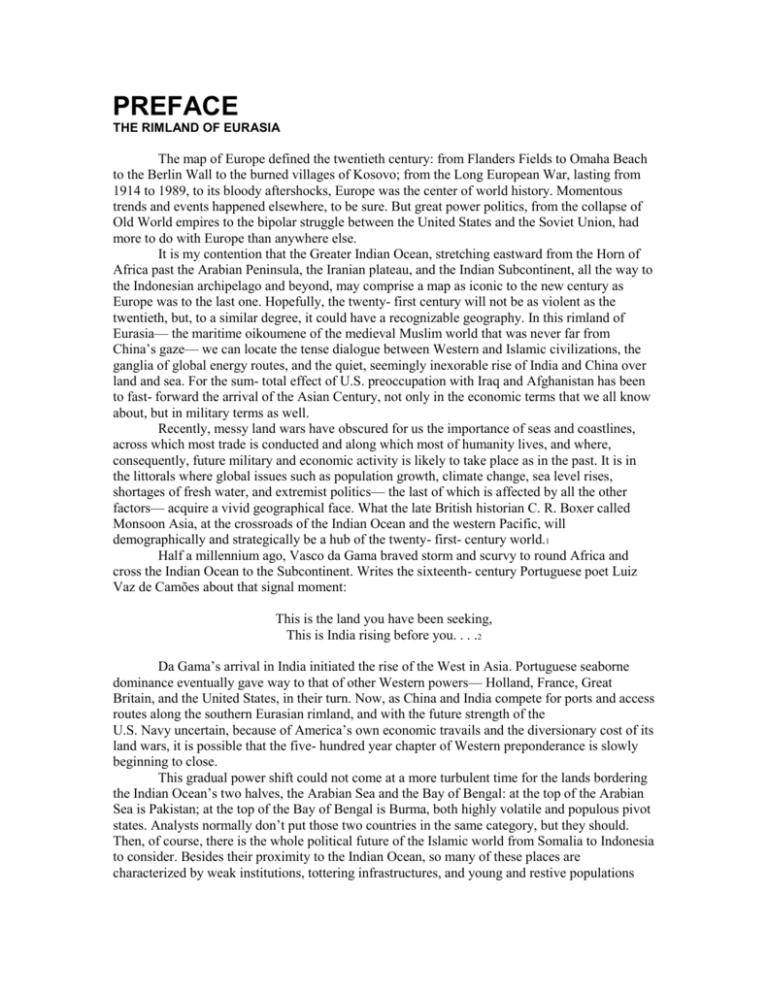
PREFACE
THE RIMLAND OF EURASIA
The map of Europe defined the twentieth century: from Flanders Fields to Omaha Beach
to the Berlin Wall to the burned villages of Kosovo; from the Long European War, lasting from
1914 to 1989, to its bloody aftershocks, Europe was the center of world history. Momentous
trends and events happened elsewhere, to be sure. But great power politics, from the collapse of
Old World empires to the bipolar struggle between the United States and the Soviet Union, had
more to do with Europe than anywhere else.
It is my contention that the Greater Indian Ocean, stretching eastward from the Horn of
Africa past the Arabian Peninsula, the Iranian plateau, and the Indian Subcontinent, all the way to
the Indonesian archipelago and beyond, may comprise a map as iconic to the new century as
Europe was to the last one. Hopefully, the twenty- first century will not be as violent as the
twentieth, but, to a similar degree, it could have a recognizable geography. In this rimland of
Eurasia— the maritime oikoumene of the medieval Muslim world that was never far from
China’s gaze— we can locate the tense dialogue between Western and Islamic civilizations, the
ganglia of global energy routes, and the quiet, seemingly inexorable rise of India and China over
land and sea. For the sum- total effect of U.S. preoccupation with Iraq and Afghanistan has been
to fast- forward the arrival of the Asian Century, not only in the economic terms that we all know
about, but in military terms as well.
Recently, messy land wars have obscured for us the importance of seas and coastlines,
across which most trade is conducted and along which most of humanity lives, and where,
consequently, future military and economic activity is likely to take place as in the past. It is in
the littorals where global issues such as population growth, climate change, sea level rises,
shortages of fresh water, and extremist politics— the last of which is affected by all the other
factors— acquire a vivid geographical face. What the late British historian C. R. Boxer called
Monsoon Asia, at the crossroads of the Indian Ocean and the western Pacific, will
demographically and strategically be a hub of the twenty- first- century world.1
Half a millennium ago, Vasco da Gama braved storm and scurvy to round Africa and
cross the Indian Ocean to the Subcontinent. Writes the sixteenth- century Portuguese poet Luiz
Vaz de Camões about that signal moment:
This is the land you have been seeking,
This is India rising before you. . . .2
Da Gama’s arrival in India initiated the rise of the West in Asia. Portuguese seaborne
dominance eventually gave way to that of other Western powers— Holland, France, Great
Britain, and the United States, in their turn. Now, as China and India compete for ports and access
routes along the southern Eurasian rimland, and with the future strength of the
U.S. Navy uncertain, because of America’s own economic travails and the diversionary cost of its
land wars, it is possible that the five- hundred year chapter of Western preponderance is slowly
beginning to close.
This gradual power shift could not come at a more turbulent time for the lands bordering
the Indian Ocean’s two halves, the Arabian Sea and the Bay of Bengal: at the top of the Arabian
Sea is Pakistan; at the top of the Bay of Bengal is Burma, both highly volatile and populous pivot
states. Analysts normally don’t put those two countries in the same category, but they should.
Then, of course, there is the whole political future of the Islamic world from Somalia to Indonesia
to consider. Besides their proximity to the Indian Ocean, so many of these places are
characterized by weak institutions, tottering infrastructures, and young and restive populations
tempted by extremism. Yet they are the future, much more than the graying populations of the
West.
As the late Belgian scholar Charles Verlinden once noted, the Indian Ocean “is
surrounded by not less than thirty- seven countries representing a third of the world’s
population,” and extends for more than 80 degrees in latitude and more than 100 degrees in
longitude.3 I can only visit a few points along the Indian Ocean’s seaboard and see what is
currently going on— so as to further illuminate a wider canvas, and to show what a world without
a superpower looks like on the ground.
The Indian Ocean region is more than just a stimulating geography. It is an idea because
it provides an insightful visual impression of Islam, and combines the centrality of Islam with
global energy politics and the importance of world navies, in order to show us a multi- layered,
multipolar world above and beyond the headlines in Iraq and Afghanistan; it is also an idea
because it allows us to see the world whole, within a very new and yet very old framework,
complete with its own traditions and characteristics, without having to drift into bland nostrums
about globalization.
The book begins with a broad strategic overview of the region. Then I move on to
individual locations along this great seaboard. Oman is my principal reference point, where I
consider the ocean’s medieval history, as well as the legacy of the first Western power, the
Portuguese; there, too, I ponder the perennial relationship between the sea and the desert, and
how each leads to different political paths. Then I focus on massive Chinese harbor projects
smack in the heart of zones of regional separatism in the case of Pakistan, and of ethnic rivalry in
the case of Sri Lanka. In Bangladesh, I write about the interrelationship of climate change,
extreme poverty, and Islamic radicalism. In India, I focus on Hindu extremism, which is being
overcome by economic and social dynamism. In Burma, I report on the collision between India
and China over a devastated and resource- rich landscape, and the challenges it pre - sents for
Western powers like the United States. In Indonesia, I explore the relationship between
democracy and a vibrant, syncretic Islam, so different from that in Pakistan and Bangladesh: for
Islam, as I learned in many of these places, is more intelligently considered against the backdrop
of a specific landscape and history. Finally, I consider Chinese naval expansion originating in the
eastern end of the Greater Indian Ocean, and at the western end take a peek at African renewal
through the prism of Zanzibar. Everywhere I attempt to describe the ceaseless currents of
historical change as they shape the contours of the new century. It is the intermingling of
challenges in each place— religious, economic, political, environmental— rather than each
challenge in isolation, that creates such drama.
The “monsoon” of which I speak is more than just a storm system (which it sometimes
comes across as in the English- language lexicon); it is, too, a life- affirming and beneficial
climatic phenomenon, so necessary over the centuries for trade, globalization, unity, and
progress. The monsoon is nature writ large, a spectacle of turbulence that suggests the effect of
the environment on humankind living in increasingly crowded and fragile conditions in places
like Bangladesh and Indonesia. In a densely interconnected world, America’s ability to grasp
what, in a larger sense, the monsoon represents and to recognize its manifold implications will
help determine America’s own destiny and that of the West as a whole. Thus, the Indian Ocean
may be the essential place to contemplate the future of U.S. power.
Excerpted from Monsoon by Robert Kaplan. Copyright © 2010 by Robert Kaplan.
Excerpted by permission of Random House, a division of Random House, Inc. All rights
reserved. No part of this excerpt may be reproduced or reprinted without permission in
writing from the publisher.

